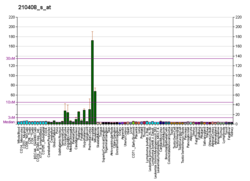| CPNE6 |
|---|
|
| Identifiers |
|---|
| Aliases | CPNE6, copine 6 |
|---|
| External IDs | OMIM: 605688; MGI: 1334445; HomoloGene: 81815; GeneCards: CPNE6; OMA:CPNE6 - orthologs |
|---|
| Gene location (Human) |
|---|
 | | Chr. | Chromosome 14 (human)[1] |
|---|
| | Band | 14q11.2 | Start | 24,070,837 bp[1] |
|---|
| End | 24,078,100 bp[1] |
|---|
|
| Gene location (Mouse) |
|---|
 | | Chr. | Chromosome 14 (mouse)[2] |
|---|
| | Band | 14|14 C3 | Start | 55,747,902 bp[2] |
|---|
| End | 55,754,888 bp[2] |
|---|
|
| RNA expression pattern |
|---|
| Bgee | | Human | Mouse (ortholog) |
|---|
| Top expressed in | - temporal lobe
- amygdala
- right hemisphere of cerebellum
- hippocampus proper
- superior frontal gyrus
- right frontal lobe
- nucleus accumbens
- anterior cingulate cortex
- prefrontal cortex
- putamen
|
| | Top expressed in | - CA3 field
- subiculum
- dentate gyrus
- dentate gyrus of hippocampal formation granule cell
- entorhinal cortex
- perirhinal cortex
- hippocampus proper
- anterior amygdaloid area
- Region I of hippocampus proper
- facial motor nucleus
|
| | More reference expression data |
|
|---|
| BioGPS | 
 | | More reference expression data |
|
|---|
|
| Gene ontology |
|---|
| Molecular function | - calcium ion binding
- transporter activity
- phosphatidylserine binding
- protein binding
- calcium-dependent phospholipid binding
| | Cellular component | - cytoplasm
- endosome
- perikaryon
- cell projection
- membrane
- clathrin-coated endocytic vesicle
- plasma membrane
- axon
- dendrite
- extracellular exosome
- cytoplasmic vesicle
- clathrin-coated vesicle
| | Biological process | - cellular response to calcium ion
- cell differentiation
- lipid metabolism
- nervous system development
- glycerophospholipid biosynthetic process
- positive regulation of dendrite extension
- vesicle-mediated transport
- chemical synaptic transmission
| | Sources:Amigo / QuickGO |
|
| Orthologs |
|---|
| Species | Human | Mouse |
|---|
| Entrez | | |
|---|
| Ensembl | | |
|---|
| UniProt | | |
|---|
| RefSeq (mRNA) | | |
|---|
NM_001136057
NM_001146183
NM_009947
NM_001360193 |
|
|---|
| RefSeq (protein) | | |
|---|
NP_001129529
NP_001139655
NP_034077
NP_001347122 |
|
|---|
| Location (UCSC) | Chr 14: 24.07 – 24.08 Mb | Chr 14: 55.75 – 55.75 Mb |
|---|
| PubMed search | [3] | [4] |
|---|
|
| Wikidata |
| View/Edit Human | View/Edit Mouse |
|



















